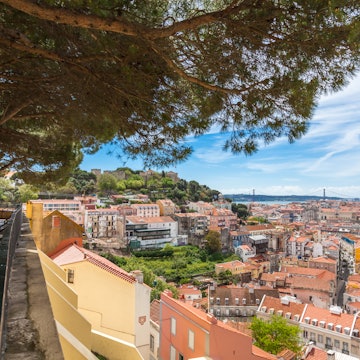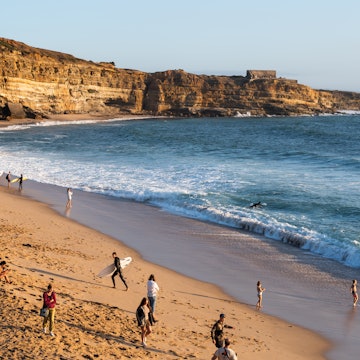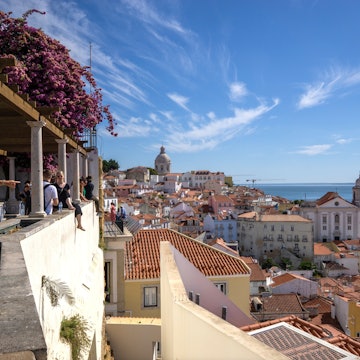

Jardim da Torre de Belém, Lisbon. Sabinoparente/Getty Images
With the sun shining brightly most of the year in Lisbon, public gardens, urban parks and picturesque squares are the place to be for people-watching and getting into the rhythm of the city. From slightly under-the-radar parks and gated romantic gardens to iconic historic locations and beautiful spots for cultural and art immersion, here's our pick of the unmissable parks in the Portuguese capital.
1. Jardim Botânico
Best park for gardeners
Jardim Botânico, Lisbon’s botanical garden, started as a scientific project in the 19th century to support students at the on-site university, now the Museum of Natural History. With more than 2000 species of trees and plants from all over the world, visitors can feel they’ve traveled to faraway destinations without leaving the city. Established as an educational garden from the start, Jardim Botânico often hosts guided tours and environment-conscious activities for kids.

2. Monsanto Forest Park
Best park for walking and family picnics
The largest green area in the city, Monsanto Forest Park is a popular weekend go-to for families with young children. The park has hiking trails, playgrounds, a skatepark and picnic areas with ready-to-use grills, and it’s easy to access by bus or car, with plenty of free parking spaces.
Planning tip: If you’re up for a hike, take the Corredor Verde de Monsanto walking path that starts at Parque Eduardo VII in central Lisbon. Intended to bring nature closer to the city, the 2.6km (1.6-mile) path takes walkers through some of Lisbon’s lovely parks and viewpoints.
3. Jardins do Bombarda
Best park for culture and art
Community-focused art project Largo Residências took over the gardens of the former psychiatric hospital Miguel Bombarda (closed since 2011). Since the summer of 2024, when it opened, Jardins do Bombarda has already established itself as one of Lisbon’s trending cultural hubs. The diverse and packed calendar of mostly free-entrance events includes workshops, concerts, art shows, fairs and markets.
Planning tip: To get a sense of the place before diving head-first into the day’s activities, pick a spot in the free-to-roam, tree-filled 2000 sq m (approx 21,500 sq ft) Pinhal (pine forest).

4. Jardim Gulbenkian
Best park for relaxing with a book or your favorite podcast
A project by Gonçalo Ribeiro Telles, an icon of Portuguese modernist landscape architecture in the 1960s, the gardens at the Gulbenkian Foundation are a work of art. The locations of each tree, plant, statue, cement bench and picnic table were meticulously planned and placed there to pay tribute to a style that became known as Portuguese Garden. Jardim Gulbenkian is an urban haven of shaded and isolated nooks, water streams and a lake, grassy clearings, an outdoor amphitheater and cafes. It’s the perfect place to get lost in a book or the latest episode of your favorite podcast, before or after perusing the art collections at the foundation’s two museums, Museu Calouste Gulbenkian and Centro de Arte Moderna.
5. Tapada das Necessidades
Best park for exercise and family outings
Tapada das Necessidades isn’t what you’d call a secret, but locals often use it more than tourists. The large lawn near the old greenhouse is ideal for family picnics or yoga classes. When it comes to maintenance, though, it’s in need of a little love, which, hopefully, will come with the planned improvement project funded by the tourist tax. In the meantime, mind the uneven pavements, loose cobblestones and rogue tree roots poking out of the dirt paths.
Planning tip: This gated, dog-friendly park in Alcântara is a little away from the city center, but still accessible by bus and tram.

6. Parque Eduardo VII
Best park for outdoor events
The manicured modernist Parque Eduardo VII is the chosen spot for some of the city’s big outdoor gatherings, including Lisbon’s Book Fair every spring, music events throughout the year and Wonderland Lisboa every Christmas. It’s more of a passing-through than a stay-in park, unless you visit Estufa Fria and Estufa Quente, the on-site greenhouses of exotic and tropical plants.
Planning tip: Don’t miss the view from the north side of the park, an often-overlooked viewpoint and a unique spot to see part of Lisbon’s downtown area all the way down to the river.
7. Largo do Carmo
Best park for old Lisbon charm and history buffs
Largo do Carmo, a small square in the Chiado quarter, was inundated by a sea of locals on April 25, 1974 when a military coup overthrew the five-decade-long conservative dictatorship, thus becoming the symbolic location of the beginning of Portugal’s democracy. In addition to being center stage for that historical event, Largo do Carmo is also known for its old Lisbon charm of black-and-white cobblestones and the Baroque fountain, the purple shade of blooming Brazilian rosewood trees in spring, and the post-1755 earthquake ruins of Convento do Carmo nearby.

8. Jardim da Estrela
Best park for romantic walks
Inspired by English gardens, Jardim da Estrela is a gated park with ponds, resident ducks, kiosks-turned-cafes and the wrought-iron bandstand that's the garden's trademark image. Take in this classic romantic setting on a long walk around the park, and peek inside Casa do Jardim da Estrela, a free-to-visit cultural center run by the city that puts on sustainability-focused cultural events and exhibitions. Squeeze in a visit to the baroque church Basílica da Estrela across the street and make time for a ride on the iconic tram 28E.
9. Jardim Amália Rodrigues
Best park for sightseeing and people watching
Jardim Amália Rodrigues (named after Portugal’s most famous fado singer) has one of uptown Lisbon’s best views. Across the street north of Parque Eduardo VII, the garden’s outdoor amphitheater has open views over Avenida da Liberdade and Rio Tejo in the background.
Despite the central location, the noise of the high traffic area easily fades into background hubhub. The artificial lake in the center is a soothing water feature that attracts clients to the nearby cafe Linha de Água (and some ducks from neighboring Gulbenkian).

10. Jardim Botânico Tropical
Best park near Lisbon’s top sights
Jardim Botânico Tropical is the closest thing to a forest refuge in the touristic neighbourhood Belém. Behind Pastéis de Belém, this 5-hectare botanical garden will hardly feel crowded or loud (provided that you ignore the resident peacocks), and it’s a cool spot to take a breather from the highly popular and always full sights nearby.
After the ticket office, the first path on the right, lined with palm trees, leads to a lake and manicured lawns. The path on the left leads to the Asian garden, a haven of tall trees and streams and ponds crossed by red bridges, with a pagoda-style sitting area.
11. Jardim da Torre de Belém
Best park for soaking up the sun and relaxing by the river
One of Lisbon’s most famous calling cards, the intricately decorated Torre de Belém – a symbol of the 15th century, Portuguese-led Age of Exploration – often divides local opinion. While some insist it’s one of the city’s must-see sights, leaning on its UNESCO World Heritage Site status, others will advise to skip the long and slow line and admire the Manueline monument from the outside instead.
Regardless of your choice, the sprawling, manicured lawns of Jardim da Torre de Belém are less crowded than other riverside parks in Lisbon and ideal to relax in the sun with a book or just the view.
















